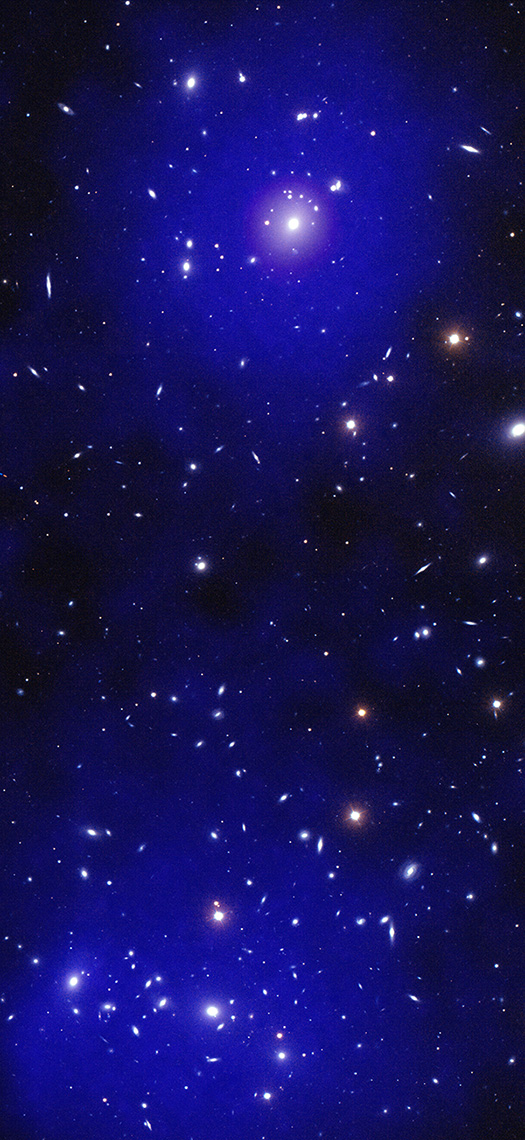For Release: October 13, 2022
NASA/CXC
Astronomers taking inventory of the material in the local universe keep coming up short. A new result from NASA’s Chandra X-ray Observatory about a system of colliding galaxy clusters may help explain this shortfall.
Although scientists know a great deal about the composition of the universe, there has been a vexing problem they have struggled to explain — there is a significant amount of matter that has not yet been accounted for.
This missing mass is not the invisible dark matter, which makes up a majority of the matter in the universe. This is a separate puzzle where about a third of the “normal” matter that was created in the first billion years or so after the big bang has yet to be detected by observations of the local universe, that is, in regions less than a few billion light-years from Earth. This matter is made up of hydrogen, helium, and other elements and makes up objects like stars, planets, and humans.
Scientists have proposed that at least some of this missing mass could be hidden in gigantic strands, or filaments, of warm to hot (temperatures of 10,000 to 10,000,000 kelvins) gas in the space in between galaxies and clusters of galaxies. They have dubbed this the “warm-hot intergalactic medium,” or WHIM.
A team of astronomers using Chandra to observe a system of colliding galaxy clusters has likely found evidence of this WHIM residing in the space between them.
“Finding these filaments of missing matter has proven to be exceptionally difficult, and only a few examples are known,” said Arnab Sarkar of the Center for Astrophysics | Harvard & Smithsonian (CfA) in Cambridge, Massachusetts, who led this study. “We are excited that we have likely pinpointed another.”
The researchers used Chandra to study Abell 98, which contains colliding galaxy clusters about 1.4 billion light-years from Earth. The Chandra data reveals a bridge of X-ray emission between two of the colliding clusters containing gas at a temperature of about 20 million kelvins and cooler gas with a temperature of about 10 million kelvins. The hotter gas in the bridge is likely from gas in the two clusters overlapping with each other. The temperature and density of the cooler gas agree with predictions for the hottest and densest gas in the WHIM.
In addition, the Chandra data shows the presence of a shock wave, which is similar to a sonic boom from a supersonic plane. This shock wave is driven by and located ahead of one of the galaxy clusters as it is starting to collide with another cluster. This is the first time astronomers have found such a shock wave in the early stages of a galaxy cluster collision, before the centers of the cluster pass by one another.
“We think this shock wave is an important discovery because our models have predicted such features should be there, but we haven’t seen one until now,” said co author Scott Randall, also of CfA. “They’re a key part of the early collision process that will eventually lead to a merger of the clusters.”
This shock wave may be directly connected to the discovery of the WHIM in Abell 98 because it has heated the gas in between the clusters as they collide. This may have raised the temperature of the gas in the WHIM filament — estimated to contain some 400 billion times the mass of the Sun — high enough to be detected with Chandra data.
Galaxy clusters — which contain thousands of galaxies, huge amounts of hot gas, and enormous reservoirs of dark matter — are the largest structures in the universe held together by gravity. Scientists think they are able to reach their colossal size by merging with one another over millions or billions of years.
“When galaxy clusters collide, we get a chance to see extreme physics that we rarely see in any other cosmic setting,” said Yuanyuan Su, a co-author from the University of Kentucky.
A paper describing this result by Sarkar et al was published in The Astrophysical Journal Letters and is available at https://arxiv.org/abs/2208.03401. Other authors on the paper are Gabriella E. Alvarez (CfA), Craig Sarazin (University of Virginia, Charlottesville, Virginia), Paul Nulsen (CfA), Elizabeth Blanton (Boston University, Boston, Massachusetts), William Forman (CfA), Christine Jones (CfA), Esra Bulbul (Max Planck Institute for Extraterrestrial Physics, Garching, Germany), John Zuhone (CfA), Felipe Andrade-Santos (CfA), Ryan Johnson (Gettysburg College, Gettysburg, Pennsylvania), and Priyanka Chakraborty (CfA).
Additional evidence for the WHIM filament between these two clusters was found with the Japan Aerospace Exploration Agency’s Suzaku, in a new paper led by Gabriella Alvarez, also of CfA. Their paper also gives evidence for the WHIM on the opposite side of the cluster that is leading the collision. These two detections of the WHIM indicate that the clusters are located along a colossal structure that is 13 million light-years long. The paper by Alvarez was recently accepted for publication in The Astrophysical Journal and is available at https://arxiv.org/abs/2206.08430.
NASA's Marshall Space Flight Center manages the Chandra program. The Smithsonian Astrophysical Observatory's Chandra X-ray Center controls science operations from Cambridge, Massachusetts, and flight operations from Burlington, Massachusetts.
Media Contacts:
Megan Watzke
Chandra X-ray Center, Cambridge, Massachusetts
617-496-7998
mwatzke@cfa.harvard.edu



